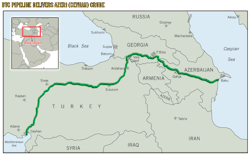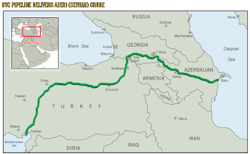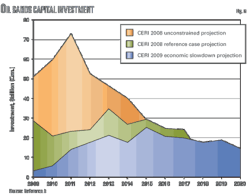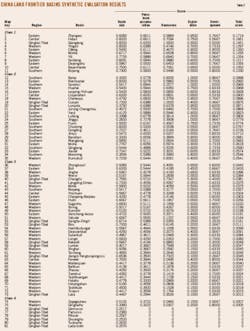Chenglin Liu
Wei Zhao
China University of Petroleum
Beijing
Jie Zhu
Ministry of Land and Resources
Beijing
According to the China National Petroleum Assessment (2003-07), there are 81 land frontier basins in China (including Qiangtang, Chuoqin, Hetao) where in-place and recoverable oil resources are 10.06 billion tons and 2.13 billion tons, 13.15% and 10.07% of the nationwide estimated resources, respectively.
In-place and recoverable gas resources are 3.02 trillion cu m and 1.76 trillion cu m, 8.61% and 8.00% of the total resource in the country. Considering various geological features, petroleum resources, exploration and development degree, and natural geographical conditions of these 81 basins, this research apportioned them into four classes, and forecasted petroleum reserves and production, under the assumption of future continuous exploration and development in these basins.
From 2011 to 2030, oil proved reserves were forecasted to be 0.97 billion tons, oil production 0.05 billion tons, gas proved reserves 134 billion cu m, and gas production 10.2 billion cu m in these 81 basins. The future oil and gas reserves and production will come mainly from the basins of Class 1 and Class 2, where the conditions of petroleum geology, resources, and exploration and development are more favorable than those of Class 3 and Class 4.
Introduction
The China National Petroleum Assessment (2003-2007), or CNPA 2007, evaluated conventional petroleum resources in 115 basins, the total area of which is 3.29 million sq km.
Among these basins are 81 onshore frontier basins (Fig. 1). Those frontier basins cover a combined area of 1.45 million sq km or 44.1% of the area of the 115 assessed basins.
Most onshore frontier basins are small. Four of them cover more than 100,000 sq km each, two cover 50,000-100,000 sq km each, 25 cover 10,000-50,000 sq km each, and 50 cover less than 10,000 sq km each.
These frontier basins were formed relatively lately, mainly during Mesozoic and Cenozoic time. There are 28 basins (34.6% of the total frontiers) formed in Mesozoic-Cenozoic, 27 basins (33.3% of the total) formed in Cenozoic, 23 basins (28.4% of the total) formed in Mesozoic, and three basins (3.7% of the total) formed in Late Paleozoic-Mesozoic). In contrast, most basins in the Eastern region were formed later than those in the Western region.
In most of these basins, geological data are mainly acquired from outcrop investigation and gravity, magnetic, and electrical exploration. Seismic data have been shot and wells drilled in only a small number of basins. The petroleum geology of many of the basins is not well understood due to the sparse level of exploration and to complex geographical and geological conditions.
Since the 1950s, international energy agencies, energy institutions of different countries, multinational petroleum companies, and experts and scholars have been studying on petroleum reserves and production forecast of the whole world, countries, and basins.2-9 In China, relevant organizations and scholars have also been researching petroleum reserves and forecasting production in all of the country's basins.10-12
Resource assessment
Table 1 illustrates the distribution of oil and gas resources in China's 81 onshore frontier basins.
The table shows oil and gas resources distribution in different strata, depth ranges, geographical conditions, and reservoir qualities.
Oil resources are mainly distributed in eight basins, with their in-place resources of more than 0.2 billion tons. The oil resources in place and recoverable resources of these eight basins total 7.87 billion tons and 1.64 billion tons, respectively, which account for 78.2% and 76.59% of all land frontier basins.
Among these eight basins, oil resources in place in Qiangtang and Cuoqin exceed 1 billion tons each, those of Hetao and Yingen are in the range of 0.3-1 billion tons, and those of Bayanhaote, Lunpola, Kekexili, and Jiangzi-Yangzuoyongcuo are in the range of 0.2-0.3 billion tons.
Gas resources are largely concentrated in eight basins, gas resources in place of which are more than 0.1 billion cu m each.
Total gas resources in place and recoverable resources of these eight basins are 2.15 trillion cu m and 1.30 trillion cu m, which account for 71.14% and 73.52% of all 81 basins, respectively.
Among these eight basins, gas resources in place in Qiangtang are the largest, more than 1 trillion cu m. Gas resources in place of Changdu, Cuoqin, Biru, Chuxiong, and Langping-Simao are in the range of 0.2-1 trillion cu m, and those of Jurong-Changzhou and Jiangzi-Yangzuoyongcuo are in the range of 0.1-0.2 trillion cu m.
Synthetic evaluation
In light of petroleum geological characteristics, oil and gas resources, exploration and development status, and natural geographical conditions of basins, this research built the petroleum synthetic evaluation standard of onshore frontier basins in China.
Based on this standard, five parameters of a basin, e.g., basin size, petroleum accumulation, resource exploration, and development, are scored. The total score of the basin is the product of the five parameters' score. The 81 basins were scored and grouped into four classes (Table 2).
With their assessed total score of more than 0.1, 11 basins (including Zhangwu and Hetao) belong to Class 1. Among 81 onshore frontier basins, these 11 basins have the most favorable petroleum geological conditions.
Total oil and gas resources in place of these 11 basins are 6.8 billion tons and 0.81 trillion cu m. These basins have the best exploration prospects and lowest exploration risk. In the next 20 years, both petroleum reserves and production will be obtained in these basins.
Another 24 basins, led by Baise and Nanhuabei, are assessed a total score in the range of 0.05-0.1 and fall into Class 2. Total oil and gas resources in place of these basins are 2.06 billion tons and 0.99 trillion cu m. These 24 basins have more favorable petroleum geological conditions, better exploration prospects, and lower exploration risk than the basins in classes 3 and 4. In the Class 2 basins, oil and gas reserves will be gained but no production is expected for 20 years.
With their assessed total score in the range of 0.001-0.05, 38 basins, led by Zhongkouzi and Boli, belong to Class 3. These basins have unfavorable petroleum geological conditions, small oil and gas resources, poor exploration prospects, and high exploration risk. In the next 20 years, few oil and gas reserves will be obtained in these basins.
Eight basins, led by Zagegaonao and Qinghaihu, are assigned total scores in the range of 0.05-0.1 and landed in Class 4. Without a large number of petroleum resources, these basins have hardly any exploration prospects.
Discovery and production forecast
How much will these frontier basins contribute to future petroleum discovery and production in China?
In order to answer this question, this study presents two sorts of forecasting methods, the exploration and development rate analog method and the graph analog method, to predict frontier basins' oil and gas reserves and production in the next 20 years, through comparison between their petroleum geology, resources, and exploration and development conditions against those of mature basins.
Oil forecast
Annual oil proved reserves of these 81 basins were forecast to reach 21.06 million tons at the end of 2010. All oil reserves will be from Class 1 basins.
After 2010, with the increase of oil reserves from Class 2 basins, cumulative oil proved reserves of these 81 basins will attain 180.42 million tons from 2011 to 2015.
After 2015, discovery speed will quicken and cumulative oil proved reserves of 5 years will gradually go up from 242.34 million tons in 2016-20 to 278.50 million tons in 2026-30. Annual oil proved reserves will also increase from 27.82 million tons of 2015 to 55.7 million tons in 2030.
At the end of 2010, yearly oil production was predicted to be 0.06 million tons in the 81 land frontier basins, with all oil production coming from the Baise and Jinggu basins. Oil production from Class 1 basins will begin to increase after 2010. Cumulative oil production in 2011-15 will reach 9.38 million tons, and that of 2016-20 and 2021-25 will keep on this level.
The yearly oil production of 2015, 2020, and 2025 will be about 1.88 million tons. After 2025, the Qiangtang basin will have oil production capacity and total oil production will increase to great degree. Average yearly and cumulative oil production of 2026-30 is 2.20 million tons and 10.99 accumulative in Qiangtang.
In these 81 basins, total accumulative oil production in 2026-30 is 20.28 million tons, and yearly oil production in 2030 is 4.08 million tons. Oil production of these frontier basins will account for more and more proportion of countrywide production in the future (Fig. 2).
Gas forecast
In the 81 land frontier basins, annual gas proved reserves were forecast to attain 1.13 billion cu m at yearend 2010, when all gas reserves will be from Class 1 basins.
From 2011 to 2015, gas reserves will go up to great degree, with cumulative proved reserves of 2.88 billion cu m. At the end of 2015, yearly gas reserves will reach 10.05 billion cu m. After 2015, gas discovery speed will keep constant, with yearly proved reserves of about 9 billion cu m.
At yearend 2010, annual gas production was predicted to be 0.06 billion cu m in these frontiers, where all gas production will come from the Baise, Luliang, and Baoshan basins. After 2010, gas production from Class 1 basins will begin to go up.
Cumulative gas production in 2011-15 will attain 1.81 billion cu m and yearly gas production of 2015 will be 0.36 billion cu m. Gas production will keep on this level from 2016 to 2025. After 2025, total gas production of these land frontier basins will increase because of gas production capacity from Qiangtang.
In these 81 basins, total cumulative gas production in 2026-30 will reach 4.76 billion cu m, and annual gas production of 2030 will be 1.33 billion cu m. However, gas reserves and production of these frontier basins will totally account for small proportion of nationwide reserves and production in the next 20 years (Fig. 3).
References
1. Li, G.Y., and Lu, M.G., et al., "Atlas of China's petroliferous basins," Petroleum Industry Press, Beijing, 2002, 2nd Edition.
2. Hubbert, M.K., "Energy from fossil fuels," Science, Vol. 109, No. 2823, 1949, pp. 103-09.
3. Hubbert, M.K., "Degree of Advancement of Petroleum Exploration in the United States," AAPG Bull., Vol. 52, No. 11, 1967, pp. 2,207-27.
4. Wattenberg, R.A., "Oil Production Trends in the CIS," World Oil, Vol. 6, 1994, pp. 91-97.
5. Campbell, C.J., "The end of cheap oil," Scientific American, Vol. 278, No. 3, 1998, pp. 78-83.
6. Masters, C.D., Root, D.H., and Turner, R.M., "World Conventional Crude Oil and Natural Gas: Identified Reserves, Undiscovered Resources and Futures," US Geological Survey Open-File Report 98-468, 1998, pp. 98-108 (http://energy.er.usgs.gov/products/openfile/OFR98-468).
7. Bartlett, A.A., "An analysis of US and world oil production patterns using Hubbert-Style curves," Mathematical Geology, Vol. 32, No. 1, 1999, pp. 1-17.
8. Bentley, R.W., "Global oil & gas depletion: an overview," Energy Policy, Vol. 30, 2002, pp. 189-205.
9. Laherrere, J.H., "The Hubbert curve: Its strengths and weaknesses," OGJ, Vol. 98, No. 16, 2004, p. 63.
10. Zhao, X.D., "The forecast on limited life based on Weng's model," Chinese Science Bull., Vol. 32, No. 18, 1987, pp. 1,406-09.
11. Chen, Y.Q., Hu, J.G., and Zhang, D.J., "Derivation of Logistic model and its self-regression method," Xinjiang Petroleum Geology, Vol. 17, No. 2, 1996, pp. 150-55.
12. Guo, Y.L., Zhong, G.H., and Zhao, L.Q., "A preliminary analysis of increasing character of oil reserves in China," Xinjiang Petroleum Geology, Vol. 22, No. 4, 2001, pp. 280-83.
The authors
Chenglin Liu ([email protected]) was with the Research Institute of Petroleum Exploration and Development, Petrochina, from 1994 to 1999 and has been with China University of Petroleum working on petroleum resources assessment since 2004. He received a BA in petroleum geosciences and a PhD in mineralogy, petrology, and mineral deposit geology from China University of Petroleum.
Wei Zhao ([email protected]) has been with China University of Petroleum studying for his master's degree in petroleum geosciences since 2009. He received a BA in geographic information systems from China University of Geoscience.
Jie Zhu ([email protected]) has been with Strategic Research Center for Oil & Gas Resources of the Ministry of Land and Resources working on petroleum resources assessment and energy strategy since 2007. He received a BA in petroleum geosciences and a PhD in geological resources and geological engineering from China University of Petroleum.
More Oil & Gas Journal Current Issue Articles
More Oil & Gas Journal Archives Issue Articles
View Oil and Gas Articles on PennEnergy.com







